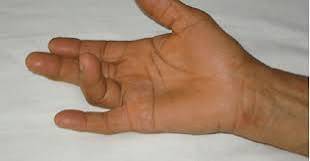Stenosing Tenosynovitis (Trigger Finger)
Stenosing tenosynovitis, commonly known as "trigger finger," occurs when the tendon that controls the movement of the fingers or thumb becomes inflamed and thickened. This condition causes the affected finger or thumb to get stuck in a bent position and may "click" when straightened.
---
20 Causes of Stenosing Tenosynovitis
1. Repetitive Hand Movements: Overuse from typing, gripping, or using tools.
2. Arthritis: Rheumatoid or osteoarthritis can lead to inflammation in tendons.
3. Diabetes: Increases the risk of tendon inflammation.
4. Age: More common in individuals over the age of 40.
5. Gout: Uric acid buildup causes joint inflammation, affecting tendons.
6. Gender: Women are more prone to developing trigger finger than men.
7. Occupation: Jobs requiring repetitive gripping, such as construction or assembly line work.
8. Vibrating Tools: Using power tools or machinery that cause vibrations can irritate tendons.
9. Previous Hand Injuries: Tendon damage or trauma to the hand can trigger this condition.
10. Tendonitis: General inflammation of tendons may lead to thickening and irritation.
11. Inflammatory Diseases: Conditions like lupus can cause tendon inflammation.
12. Carpal Tunnel Syndrome: Co-occurrence with CTS due to pressure on the tendons.
13. Obesity: Increased pressure on tendons due to extra weight.
14. Hypothyroidism: Slows metabolism and contributes to tissue thickening, affecting tendons.
15. Pregnancy: Hormonal changes can lead to swelling in the tendons.
16. Chronic Kidney Disease: Fluid retention from kidney disease can cause tendon swelling.
17. Infection: Infection in the hand or joints can irritate tendons.
18. Congenital Abnormalities: Some people are born with smaller tendon sheaths, increasing the risk.
19. De Quervain's Tenosynovitis: A similar condition affecting the tendons in the thumb can coexist with trigger finger.
20. Smoking: Reduces blood flow to tissues, including tendons, leading to inflammation.
---
20 Signs and Symptoms of Stenosing Tenosynovitis
1. Finger Locking: Finger gets stuck in a bent position and may pop when straightened.
2. Pain in the Palm: Tenderness or pain at the base of the affected finger.
3. Swelling: Swelling or a lump (nodule) in the palm near the affected tendon.
4. Clicking Sensation: Clicking or popping when moving the finger.
5. Finger Stiffness: Difficulty in straightening the finger, especially in the morning.
6. Pain with Finger Movement: Pain increases when trying to bend or straighten the finger.
7. Limited Finger Mobility: Reduced range of motion in the affected finger.
8. Tenderness Over the Tendon: Pain when pressing on the palm over the affected tendon.
9. Warmth in the Palm: Inflammation may cause the area to feel warm to the touch.
10. Finger Locking in Flexion: Finger may remain stuck in a bent position.
11. Hand Fatigue: Increased effort to straighten the finger leads to fatigue in the hand.
12. Soreness in Other Fingers: May develop soreness in adjacent fingers due to overcompensation.
13. Pain that Radiates: Discomfort may radiate from the finger to the wrist or forearm.
14. Finger Weakness: Difficulty grasping or holding objects.
15. Decreased Grip Strength: Overall weakening of the hand’s ability to hold objects.
16. Pain with Gripping: Pain worsens when gripping or squeezing objects.
17. Finger "Catches": Finger may catch or lock before straightening fully.
18. Thickened Tendon Sheath: The sheath surrounding the tendon may feel thicker than usual.
19. Increased Pain with Activity: Symptoms often worsen with activity or repetitive motions.
20. Inability to Make a Fist: Struggling to close the hand fully due to the stuck finger.
---
10 Effects of Stenosing Tenosynovitis
1. Reduced Hand Functionality: Difficulty performing daily tasks, such as writing, buttoning, or gripping.
2. Chronic Pain: Persistent discomfort in the hand, especially when moving the affected finger.
3. Loss of Dexterity: Reduced fine motor skills, affecting precision in tasks like typing or crafting.
4. Sleep Disruption: Pain and stiffness may worsen at night, disrupting sleep.
5. Muscle Weakness: Chronic immobility of the affected finger can lead to weakening of hand muscles.
6. Emotional Stress: Constant pain and limited hand use may lead to frustration, anxiety, or depression.
7. Increased Risk of Further Injury: Limited use of the hand can cause compensatory strain on other joints and tendons.
8. Dependency on Others: Difficulty performing self-care tasks may lead to reliance on others for assistance.
9. Job Loss or Reduced Productivity: Inability to perform work-related tasks, especially in jobs requiring fine hand control.
10. Surgical Intervention: In severe cases, surgery may be required to release the tendon and restore hand function.
---
Prevention of Stenosing Tenosynovitis
1. Avoid Repetitive Movements: Take frequent breaks from tasks involving repetitive hand or finger movements.
2. Stretch Regularly: Perform hand and finger stretches to maintain flexibility in the tendons.
3. Use Ergonomic Tools: Ensure that workstations and tools are designed to reduce strain on the hands.
4. Alternate Hand Use: Try alternating hands during repetitive tasks to avoid overuse of one hand.
5. Maintain a Healthy Weight: Reduce pressure on the tendons by maintaining a healthy body weight.
6. Use Protective Equipment: Wear gloves or wrist supports during activities that involve vibrating tools or heavy lifting.
7. Stay Hydrated: Proper hydration reduces the likelihood of tendon irritation and inflammation.
8. Manage Underlying Conditions: Control diabetes, arthritis, and other health conditions that increase the risk of trigger finger.
9. Strengthen Hand Muscles: Engage in exercises to strengthen the muscles that support the tendons.
10. Avoid Gripping Hard Objects for Long Periods: Minimize extended gripping, pinching, or squeezing to reduce strain on the tendons.
By recognizing early signs and taking preventive steps, stenosing tenosynovitis can be managed to prevent further complications. Early intervention and lifestyle changes are key to reducing the risk of developing this condition.


